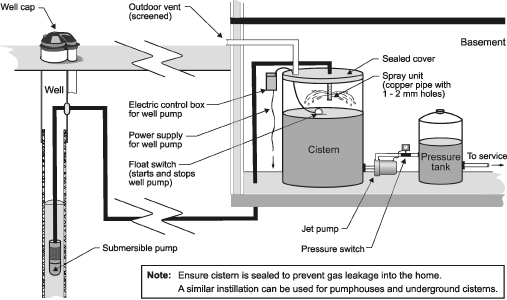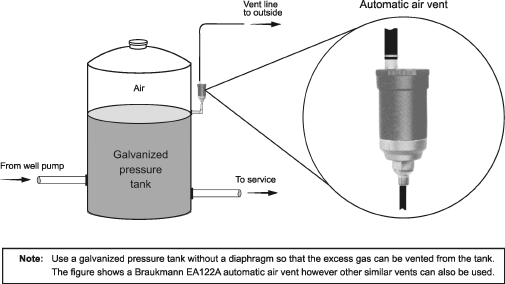| | Common terms | Methane in well water | Detecting methane in wells and air | Removing methane from well water | Protecting your water wells | Coal bed methane (CBM) requirements
Methane is a colourless, odourless gas and is lighter than air. Methane is not considered toxic, but it is an asphyxiant at a concentration of over 50 per cent in air. Methane is extremely flammable and can be easily ignited by heat, sparks or flames. Methane is explosive at volumes of 5 per cent to 15 per cent (50,000 ppm to 150,000 ppm) in air. Although methane will rise, it can displace oxygen in confined spaces such as cisterns, pumphouses or well pits.
Common Terms
Gas concentrations are commonly referred to in percentage of air by volume (%) or parts per million (ppm). The following examples indicate how to convert between ppm and per cent. The lower explosive limit (LEL) is the minimum amount of a gas in the air that can cause an explosion. This limit is 5 per cent for methane.
1. convert ppm to %
2. convert % to ppm
78% x 10,000 = 780,000 ppm
A gas concentration of 10 per cent or more of the Lower Explosive Limit in a confined space is considered to be a safety hazard. For methane, this limit works out to over 5,000 ppm.
Methane in Well Water
Gases (not dissolved in water) can migrate into wells that are not properly cased. Gas can also be naturally present in the water in an aquifer. For example, the Ardley coal zone is present in the Scollard Formation, which is the major aquifer in central Alberta. A water well completed in the Scollard Formation can yield gas if the gas-bearing zone is not cased and sealed off. Well drillers are required to report and seal off gas that could be dangerous to the drilling operation or operation of the well.
Methane can also migrate from coal seams into sandstone aquifers. If methane is present in an aquifer, it will likely exist as a dissolved gas in the water. When the well is pumped, the water level is drawn down. The drawdown will lower the pressure in the well and allow more gas to be released from the water. Methane will readily move from the water phase to the gas phase when water pressure is reduced to atmospheric pressure at the ground surface.
Detecting Methane in Wells and Air
Handheld gas detectors can be rented from a number of environmental equipment suppliers for approximately
$60 per day. There are many types of equipment, so it is important to discuss what equipment will be useful to test for methane. The supplier should calibrate the equipment, so that you can take accurate measurements, and should also provide an operation manual. Some suppliers will provide training on equipment use.
Field monitoring equipment is only useful for air measurements above ground. These results will not be as accurate as a laboratory test but may tell you whether or not a laboratory test is necessary and will provide an immediate indication of methane levels.
A water sample or a gas sample can be collected and analyzed for methane content. Testing for methane dissolved in well water must be performed carefully because methane will move into the gas phase easily. A laboratory should be consulted regarding appropriate sample collection procedures and sample containers.
Most laboratories will analyze water or gas for methane content. The laboratory results will indicate the ppm or per cent concentration of methane present.
Removing Methane From Well Water
Methane will escape from the water when the pressure is released or when the water is heated. Depending on the amount of methane and pressure, some gas will often separate from the water in a pressure tank or a hot water heater. It is not uncommon to have this gas "spurt" out of household water taps. Gas will also build up in the tank and escape into water lines.
A galvanized pressure tank with an automatic air vent will allow gases to escape from the tank to the outside air. If large volumes of gas are present in the well, a vented pressure tank may not be sufficient to disperse the gas. In this case, a cistern with a spray unit and vent can be installed before the pressure tank. The spray unit helps separate dissolved gases from water, so they can be vented outside. Figure 1 and 2 illustrate both the pressure tank and aeration options.

Figure 1. Aeration and ventilation system

Figure 2. Galvanized pressure tank
Some wells have enough dissolved gas in them to cause gas locking of the pump. For more information, see the factsheet Dissolved Gases in Well Water, Agdex 716 (D18), on the Alberta Agriculture and Forestry website.
Protecting Your Water Wells
It is important to monitor your water wells on a regular basis, especially before seismic and oil/gas drilling activities start. Have both a routine analysis and a microbiological analysis performed. The non-pumping water level should also be monitored on a regular basis.
A professional should be contracted if a test for methane in water is required and to test well production. Well production tests do not need to test how hard the well can be pumped but should be pumped at a sustainable rate using a test procedure that can be duplicated at a later date.
Coal Bed Methane (CBM) Requirements
In April 2006, Alberta Environment released the document Standard for Baseline Water-Well Testing for Coalbed Methane/Natural Gas in Coal Operations. This document states that CBM developers must test water wells within a minimum 600 metre radius of a CBM well that is completed above the base of groundwater protection.
The base of groundwater protection is the depth above which potable water can be found and varies throughout the province. Potable water is considered to have less than 4,000 mg/L of total dissolved solids (TDS). If no water wells are located within a 600 metre radius, testing must be performed on water wells within an 800 metre radius.
The testing that must be performed includes water well capacity, routine potability, bacteriological, and presence and analysis of gas.
References
For more information, see the following publications:
Methane Safety, Agdex 729-2,
Alberta Environment's Standard for Baseline Water-Well Testing for Coalbed Methane/Natural Gas in Coal Operations, April 2006
Alberta Agriculture and Forestry, Dissolved Gases in Well Water, Agdex 716 (D18),
Coal Bed Methane (CBM) Wells and Water Well Protection
For more information
Additional information is available through Agricultural Water Specialists or on the Alberta Agriculture and Forestry website.
Agricultural Water Specialists can be contacted through the Alberta Ag-Info Centre at 310-FARM (3276).
Prepared by:
Farm Water Supply Branch
Alberta Agriculture and Forestry
Source:Agdex 716 (D63). June 2006. |
|